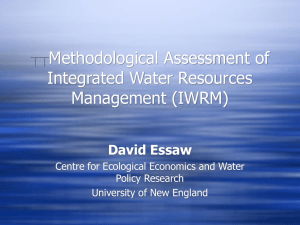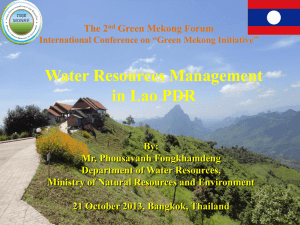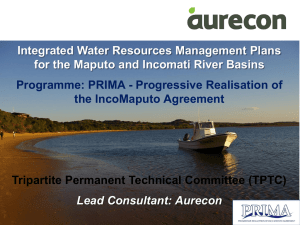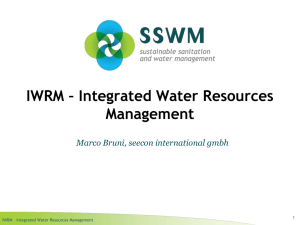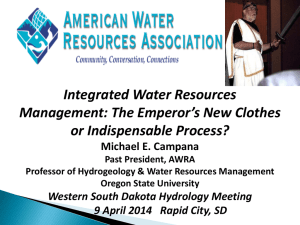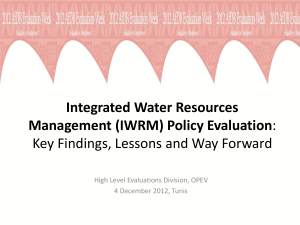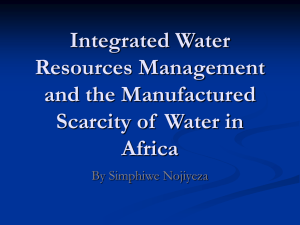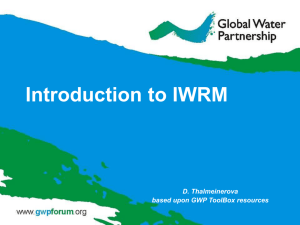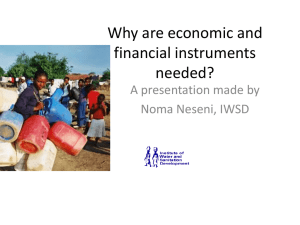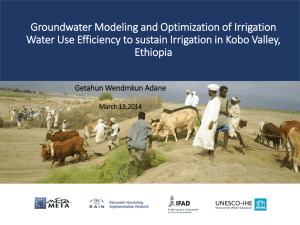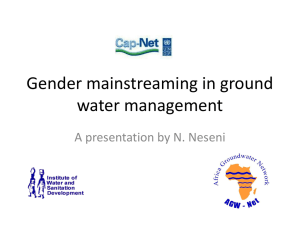Introduction to IWRM - Global Water Partnership
advertisement
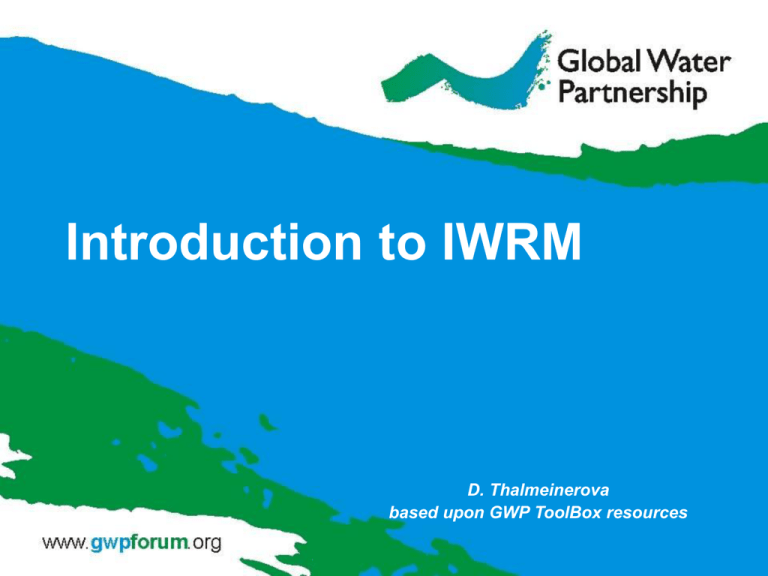
Introduction to IWRM D. Thalmeinerova based upon GWP ToolBox resources Local, Regional, National, Fluvial, Global Ancient 1200 A.D. 1900 1990s Future Community Basic management of water quantity Sectoral management of water quantity and quality institutional fragmentation spatial fragmentation local co-ordination Integrated multifunctional use river basin as unit institutionalised cooperation Multi-level Comprehensive Governance Before we start…. • The basis of IWRM is that different uses of water are interdependent • Integrated management means that all the different uses of water resources are considered together WATER CYCLE Driving forces on water resources • • • • • • Population growth: demands for more water and producing more waste water and pollution Urbanization: migration from rural to urban areas which increases the current level of difficulty in water delivery and waste water treatment Economic growth: mainly in developing countries with large populations contributes to increased demand for economic activities Globalization of trade: production is relocated to “labor-cheap” areas that takes place without consideration for water resources Climate variability: more intense floods and droughts increase vulnerability of people Climate change: increase uncertainty about water cycle regimes IWRM concept is • • • • • • an empirical concept which is built up from the on-the-ground experience of practitioners, a flexible approach to water management that can adapt to diverse national and local contexts, thus it is not a scientific theory that needs to be proved or disproved by scholars. and (but) it requires policy-makers to make judgments about which reforms and measures, management tools and institutional arrangements are most appropriate in a particular cultural, social, political, economic and environmental context. IWRM definition IWRM is a process which promotes the coordinated development and management of water, land and related resources, in order to maximize the resultant economic and social welfare in an equitable manner without compromising the sustainability of vital ecosystems. GWP, TEC Background Paper No. 4: Integrated Water Resources Management IWRM: What does it really mean? • More coordinated development and management of: – Land and water – Surface water and ground water – Upstream and downstream interests Discussion questions: Who should propose measures to protect against floods? Who should bear a cost to implement measures to mitigate floods? Key water resources management functions • • • • • • • • Water allocation Pollution control Monitoring Financial management Flood and drought management Information management Basin planning Stakeholder participation IWRM Manage water resources within a basin • • • • • What about international basins? What about large distances within a basin (with disparate communities and institutions)? How to manage a basin that has no monitoring network? How to manage a basin where water supply and demand fluctuate both intra-seasonally and inter-annually? How to manage a basin where authorities have a little access to financial, transport and technological capabilities? Three pillars of IWRM • Implementing IWRM process is a question of getting the “three pillars” right: 1. Moving towards enabling environment of appropriate policies, strategies and legislation 2. Putting in place the institutional framework (through which policies can be implemented) 3. Setting up the management instruments required by these institutions to do their job CHANGE AREAS CHANGES ARE MADE TO SEEK Economic Efficiency Social Equity TO REACH SUSTAINABILITY Environmental Sustainability Managing competing uses Cross-sectoral integration • Enabling environment • Institutions • Management instruments Water for people Water for food Water for nature Water for other uses Integrating across levels and sectors National Basin Local Energy Fisheries Envir onme nt Agriculture Water Finance Tourism Industry IWRM PRINCIPLES • Fresh water is a finite and vulnerable resource, essential to sustain life, development and the environment. • Water development and management should be based on a participatory approach, involving users, planners and policymakers at all levels. • Women play a central part in the provision, management and safeguarding of water. • Water has an economic value in all its competing uses and should be recognized as an economic good as well as social good. Dublin, 1992 IWRM Principles • Fresh water is a finite and vulnerable resource, essential to sustain life, development and the environment. Respecting the basin IWRM Principles • Water development and management should be based on a participatory approach, involving users, planners and policymakers at all levels. Difficult to ensure “active involvement” 50 200 2 000 200 000 2 500 000 decision work participation information population Pitfalls in putting IWRM into practice Trying to establish management relations between too many variables risks getting mired in complexity at the expense of effectiveness. When putting IWRM into practice it’s important to think strategically about where and to what degree coordination and new management instruments are necessary. IWRM Principles • Women play a central part in the provision, management and safeguarding of water Source: The Economist IWRM Principles • Water has an economic value in all its competing uses and should be recognized as an economic good as well as social good – Water is becoming scarcer and its value rising – Recognition that costs should be borne by those who benefit Arguments for treating water as an economic good: Arguments for treating water as a human right: • • • • • • • Market-based approach will ensure that people are better stewards of water resources Encourages conservation Improves quality Helps allocate water to maximize benefits • Ensures water for all Helps set priorities of water policy Focuses attention on resolving water conflict Helps safeguard other human rights Why IWRM? • • • • • Globally accepted and makes good sense. Key element in national water policy. Incorporates social and environmental considerations directly into policy and decision making. Directly involves the stakeholders. Is a tool for optimizing investments under tight financing climate. Traditional versus IWRM approaches …in order to understand better “integrated” approach… • Traditional approach • Integrated approach – One sector – Multi sectors – Limited institutions involved – Various institutions involved – Decision making at one sector – “collective” decision making – Specific issues addressed – Complex issues addressed – Specific interests solved – Overriding interests solved – Sectoral allocation of funds – National allocation of funds In order to understand better “integrated” approach Traditional approach: Integrated approach: • • How will new investment be agreed upon? • How can local management structures balance competing uses? • How will stakeholders negotiate water rights in different conditions of water availability (scarcity)? • How will consumers respond to periodic water shortages or to increasing environmental concerns? Hydrological/hydraulic – What is expected yield of the catchment? • Engineering – How much water leaks from the system? – How can leakage be reduced? • Management – What is the economic level of leakage? Lessons learnt Risks of fully sectoral approach Overlooking negative impacts on environment and other sectors Inefficient use of resources—natural and financial Risks of fully integrated approach Getting mired in complexity. Not making good use of specialist expertise. Finding a balance Integrate d approach Each country needs to decide where integration makes sense based on its social, political and hydrological situation. Sectoral approac h The nature of IWRM: Lessons from IWRM in practice How water is developed and managed must reflect country priorities (including environmental standards) and governance approaches. Water management will not be successful if it is set up as a stand-alone system of governance and administration, separate to the rest of government. Examples: IWRM is linked to key development issues Key development issue How IWRM helps Example Securing food production Assists the efficient production of food crops in irrigated agriculture FAO round table (2003, Rome) agreed that all African countries should improve efficiency in irrigated agriculture for food production by adopting IWRM approach Reducing health risks Better management of water quality UNECE Protocol on Water and Health (2007) requires to set health targets. Progress towards IWRM has been chosen as an indicator for improved water management Freshwater and coastal water IWRM recognizes freshwater and coastal zone as a continuum Integrated Coastal Area and River Basin Management (ICARM) is endorsed by GWP as a basic concept for the GEF projects portfolio Key development issue How IWRM helps Example Mitigating disaster risks Assists disaster preparedness WMO adopted IFM approach within the framework of IWRM in 2000 Planning transboundary cooperation Assists water management of shared basins ECOWAS adopted the West African Regional Action Plan for IWRM in 2000. The IWRM is a framework for transboundary Niger, Volta and Senegal rivers Adapting to climate change Assist appropriate planning of water use with better resilience IPCC emphasizes IWRM approach that is based on the concepts of flexibility and adaptability Summary about IWRM: what we have learnt • • • • • • IWRM is linked to sustainable development IWRM is not a one-size-fits-all prescription and cannot be applied as a checklist of actions IWRM is not a prescription but an iterative process and an adaptive approach IWRM implementation must reflect country priorities Water management will not be successful if it is set up as a stand-alone system of governance IWRM includes both ‘hard’ and ‘soft’ components Lessons from IWRM in practice IWRM is a means not an end. None of the successful case studies analysed set out to achieve IWRM. Rather they set out to solve particular water-related problems or achieve development goals by looking at water holistically within larger physical and development contexts. Equity Sustainability Efficiency IWRM
